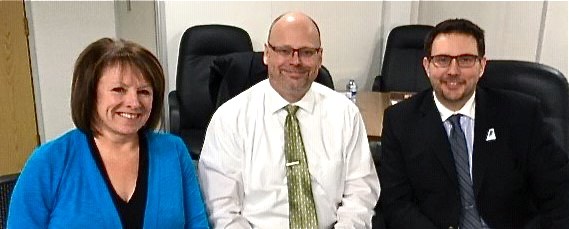A three-person team of superintendents and director of education, Lynn Little, provided a foray into an ambitious monitoring report that was delivered to the South East Cornerstone Public School Division’s (SECPSD) board of trustees on Feb. 12.
The board had assembled for their regular monthly afternoon general business session following their in-camera discussions earlier that day.
The report focused on the division’s System No 3 goal that states the division and schools are to effectively use the information to measure, monitor and report continuous improvement.
That was the division’s “core business,” said Little in introducing the participants that included Kevin Hengen, superintendent of schools in the eastern region of the sprawling Cornerstone domain; Shelley Sargent, superintendent for the southern area and Gord Husband, superintendent for the schools on the western side of the division.
“Our actions are data-driven,” said Little in her opening remarks. “The data drives financial and student services purposes, but the core is student achievement.”
The presentation and the data provided are, “examples of coming together to share the data and how we use it.” She went on to explain how data is provided and shared at almost every administration meeting.
Sargent was the first up for the trio of superintendents and she centred her attention on data gathered using the SAYCW system (Saskatchewan Alliance for Youth and Community Well Being). This is the partnership among health, education and other community stakeholders.
The SAYCW communities conducted surveys and collected data from students from Grades 7 to 12 and those results are now in school division safekeeping. The survey looked at such things as general health, family, friends, community, culture identity, physical activity, school engagement, mental health, substance abuse and nutrition, among other things.
Sargent spent the majority of her time delivering statistical information on mental health issues as well as the physical, emotional and spiritual well being of the students who had taken the survey. The survey first, indicated a lower sense of well being among female students versus their male counterparts. That included questions about depression, self-harm and suicidal thoughts where 531 students indicated in the survey they had at least considered suicide at one time whereas another 2,077 had not.
“Overall results will be analyzed at the division level and when the schools are able to get the results they will analyze in all categories and develop an action plan,” Sargent said. To that end, a mental health consultant, Raylene Forseth had been hired to work in the division to address these needs and to focus on the three areas of prevention, intervention and post-intervention.
In response to questions from the board members, Little said there were hopes that the consultant’s position could be retained and maintained within the current and future budgets.
So far, the schools have not received the data, but, Sargent said, “we see common pieces so when school staff see them, they can dig into the stats and plan a course of action.”
“The analysis gives us time to respond with a plan,” said Little
“The support team then drills down to the school,” said Sargent, who went on to explain prevention and intervention and post-intervention planning and developments. She also noted there were universal behaviour screenings done for all Grade 4 to 12 students and teachers also complete a survey on all students.
So far, the teacher and student surveys are showing almost identical results, verifying the veracity of the system being deployed.
Hengen then led the group through data analysis of English language arts and mathematics results within the division stating that “we look for patterns, we look at patterns and the teacher can view and track the student’s progress year-by-year to see if they are working at grade levels.”
The data displayed for this monitoring area began in the 2016-17 academic year.
“If the students aren’t reaching the target, then we have administration meetings to find out what we can do to elevate the results.”
A series of graphs gave the board members a concept of how well the Cornerstone students were doing in these two key subject areas and provided projected credits within a highschool credit summary graph.
“We check the courses taken, what has been achieved and what is required for graduation. We have a snapshot of the group and then we can dig down if necessary,” said Hengen. That could involve a credit recovery program after “we see what the students are missing.”
Husband focused his part of the presentation on the Lexia Core 5 program. Lexia is a parent company that provides two learning platforms with Core 5 being Tier 1 instruction for Grades 2-5 and PowerUp for Tier 2 instruction for Grades 6 and up.
The data achieved through Core 5 plus the instructional resources, he explained, allows for division-level data as well as school and classroom data collection which is used to assess program effectiveness.
Core 5 data usage is monitored to determine usage, progress, predictors and certification, or, he said, celebration … meaning a successful conclusion for a student.
Every four weeks superintendents receive a report on usage of the Core 5 system within each school and they have access to a dashboard of cumulative data of all schools as well as information from each school so they can engage in meaningful discussions with the schools’ principals.
Husband talked about skill-building for students and quick information results for teachers that leads to “levels and targets for small group instruction. Some youngsters maybe only need 20 minutes while others might require 80 minutes on some program,” he said, as an example.
“A lot of teachers are using it, checking into it around Wednesday so they can dive in and drive their instruction accordingly,” Husband said.
The half-hour session was met with several queries from the board members during and after the presentation.



